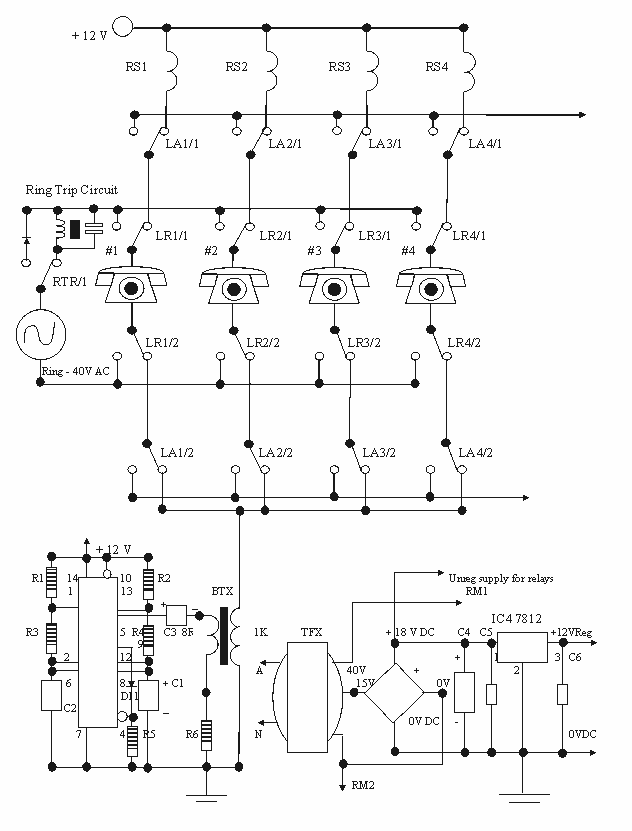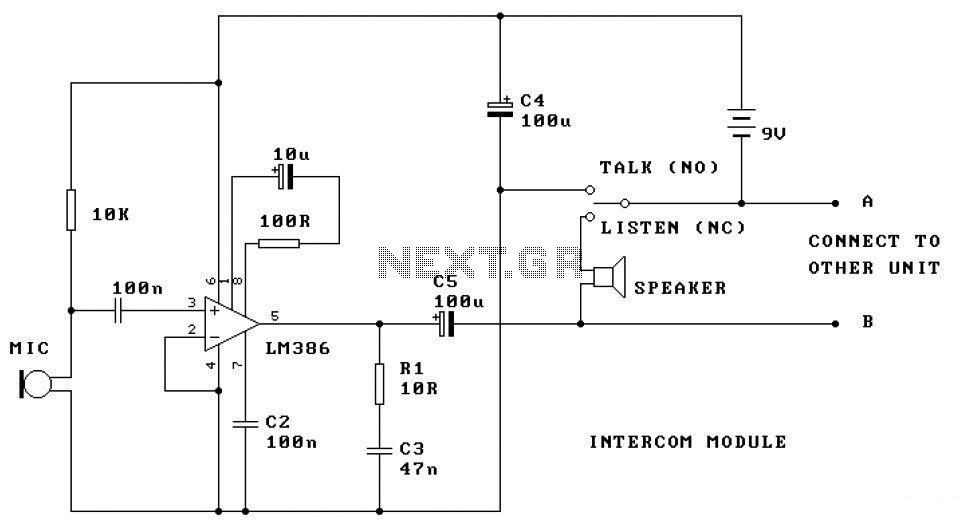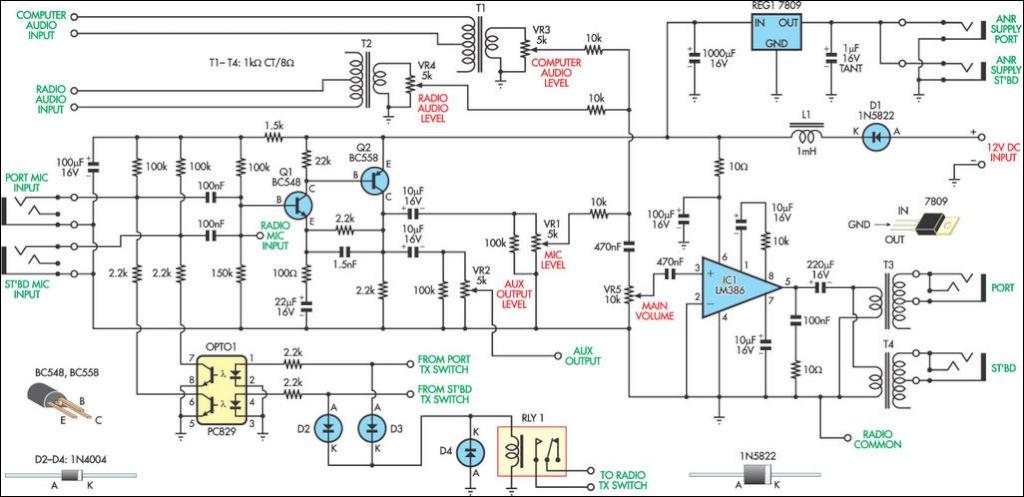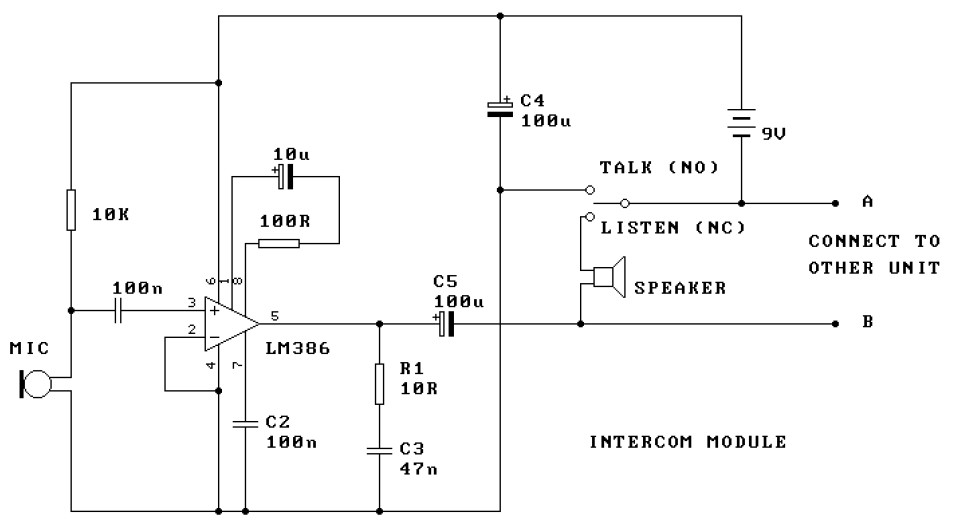
Intercom

The circuit consists of separate amplifiers, one for each station, rather than a single amplifier with a time-sharing arrangement. U1 and U2 are low-voltage audio amplifiers, each operating as independent units with switches at either station controlling which will transmit or receive. With capacitors C7 and C8 included in the circuit, the amplifiers have a gain of 200. Omitting these two components reduces the gain to approximately 20.
Other gain levels can be achieved by adding a series-connected resistor-capacitor (R/C) combination between pin 1 and pin 8. For instance, using a 1000-ohm resistor in series with a 10 µF capacitor results in a gain of about 150.
The described circuit employs two independent low-voltage audio amplifiers, designated as U1 and U2, to facilitate audio transmission and reception at two separate stations. This design choice eliminates the complexity of a single amplifier with time-sharing capabilities, allowing each station to operate autonomously. The configuration provides flexibility in controlling which amplifier is active at any given time via manual switches, enhancing usability in various applications.
Capacitors C7 and C8 play a critical role in establishing the amplifiers' gain. When included in the circuit, they enable a high gain of 200, which is beneficial for applications requiring amplified audio signals. Conversely, the removal of these capacitors significantly reduces the gain to approximately 20, indicating their importance in achieving the desired amplification level.
For applications requiring different gain settings, the circuit allows for customization through the addition of a series-connected resistor-capacitor (R/C) network. By connecting a resistor, such as a 1000-ohm component, in series with a capacitor, such as a 10 µF unit, between specific pins (pin 1 and pin 8), the gain can be adjusted to approximately 150. This feature provides versatility in the circuit's performance, making it adaptable to various audio amplification needs.
Overall, the design's modularity and the ability to tailor gain levels through component selection make it suitable for diverse audio applications, ensuring optimal performance based on specific requirements.The circuit consists of separate amplifiers—one for each station—rather than a single amplifier and a time sharing arrangement. Ul and U2 are low-voltage audio amplifiers, each of which operates as separate entities with switches at either station controlling which will transmit or receive.
With capacitors C7 and C8 included in the circuit, the amplifiers have a gain of 200. Omitting those two components drops the gain to about 20. Other gain levels are available with the addition of a series-connected R/C combination connected between pin 1 and pin 8—for example, a 1000 ohm resistor and 10 µ¥ capacitor for a gain of about 150.
Other gain levels can be achieved by adding a series-connected resistor-capacitor (R/C) combination between pin 1 and pin 8. For instance, using a 1000-ohm resistor in series with a 10 µF capacitor results in a gain of about 150.
The described circuit employs two independent low-voltage audio amplifiers, designated as U1 and U2, to facilitate audio transmission and reception at two separate stations. This design choice eliminates the complexity of a single amplifier with time-sharing capabilities, allowing each station to operate autonomously. The configuration provides flexibility in controlling which amplifier is active at any given time via manual switches, enhancing usability in various applications.
Capacitors C7 and C8 play a critical role in establishing the amplifiers' gain. When included in the circuit, they enable a high gain of 200, which is beneficial for applications requiring amplified audio signals. Conversely, the removal of these capacitors significantly reduces the gain to approximately 20, indicating their importance in achieving the desired amplification level.
For applications requiring different gain settings, the circuit allows for customization through the addition of a series-connected resistor-capacitor (R/C) network. By connecting a resistor, such as a 1000-ohm component, in series with a capacitor, such as a 10 µF unit, between specific pins (pin 1 and pin 8), the gain can be adjusted to approximately 150. This feature provides versatility in the circuit's performance, making it adaptable to various audio amplification needs.
Overall, the design's modularity and the ability to tailor gain levels through component selection make it suitable for diverse audio applications, ensuring optimal performance based on specific requirements.The circuit consists of separate amplifiers—one for each station—rather than a single amplifier and a time sharing arrangement. Ul and U2 are low-voltage audio amplifiers, each of which operates as separate entities with switches at either station controlling which will transmit or receive.
With capacitors C7 and C8 included in the circuit, the amplifiers have a gain of 200. Omitting those two components drops the gain to about 20. Other gain levels are available with the addition of a series-connected R/C combination connected between pin 1 and pin 8—for example, a 1000 ohm resistor and 10 µ¥ capacitor for a gain of about 150.





